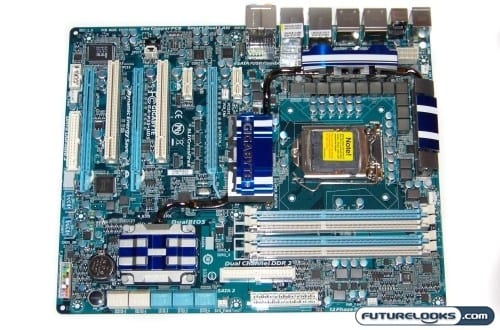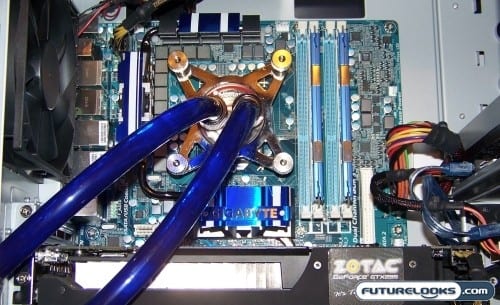GA-P55-UD5 Up Close and Personal
GIGABYTE continues using blue PCB to build their motherboard. The major change to this platform, besides the P55 Chipset, is what’s on top of it. The Southbridge and PWM get new Heat Pipes and white racing strips that remind me of a Shelby GT500 Mustang: blue, bold, striped, and bad to the bone!

One of the hot features on the Intel P55 platform is the return of dual channel DDR3 memory and a controller built specifically into the Lynnfield LGA 1156 Processors. Because it’s dual channel, engineers can squeeze out much higher frequencies up to 2200 MHz. That’s 600 MHz more than Intel’s DP55KG, but only 66 MHz more than the MSI P55-GD65. It’s funny to think that not too long ago DDR at 400MHz was considered fast.
Gamers will appreciate the CrossfireX/SLI support offered by the top two PCI Express 2.0 slots. Each slot operates in x16 mode with a single card and x8 by x8 when two cards are used. Typically, you can see minimal differences between dual x16 and dual x8 slots using really high resolutions so the loss of dual x16 slots is not a biggie. You’ll also find several clearly labeled features like horizontal SATA ports and well placed USB, 1394, and Front Panel ports or headers. The two eSATA/USB Combo ports are an especially interesting new feature that allows a bit more connectivity without making more slots. Feel free to use eSATA on one port and USB on the other. It really works.

The board also gets a large clearly marked backlit power button whereas the reset button sits more modestly behind it. Not sure why the difference in quality, but perhaps engineers are confident you won’t be needing to use it much so why waste a fancy button. Let’s get this thing installed.
Installation Notes
If you were at PAX 2009 in Seattle this year, you may have noticed the liquid cooled Intel Core i7 870 game machine at Antec’s booth. With a little inter vendor cooperation with Futurelooks, Antec, Intel, and PugetSystems, we were able to assemble an exclusive sneak peak at the “Lynnfield” processor in action.

The Koolance Exos 2.5 with CPU-350AT Water Block was used on both the GIGABYTE and challenging MSI motherboard. You’ll be pleased to know that the cooling system kept processor temps well under control and didn’t reach 80 C during testing even during overclocking. That, as you will see, is mainly due to the motherboard limiting the highest result.
One thing I have to admit about the new LGA 1156 socket is that the locking mechanism is far easier, simpler, and seems more secure than the LGA 1366. If you’re not already familiar with it, after setting the CPU in place, the latch fastens in an all-in-one movement while guiding the plate beneath the screw head.
Here is the break down of components in the test bed:
- Intel Core i7 870 “Lynnfield” Processor
- GIGABYTE GA-P55-UD5 Motherboard
- MSI P55-GD65 Motherboard
- Patriot 4GB 2000 MHz Sector 5 Dual Channel Memory
- Zotac Geforce GTX295
- Kingston 64GB SSDNow V+ Solid State Drive
- 1000 Watt Power Supply
- Windows 7 (Final RC)
- Latest BIOS, motherboard, and video drivers.
Once the test system was ready, I had to check out the Smart TPM encryption feature. It’s really simple once you get the security key and as long as your phone supports Bluetooth. Basically, without my cell phone, no one is able to access or do anything to the system. This is would really benefit a demo rig at any LAN Party. Just keep your cell phone charged and you’ll be fine. And, it wouldn’t hurt to have a USB pen drive key back up.
